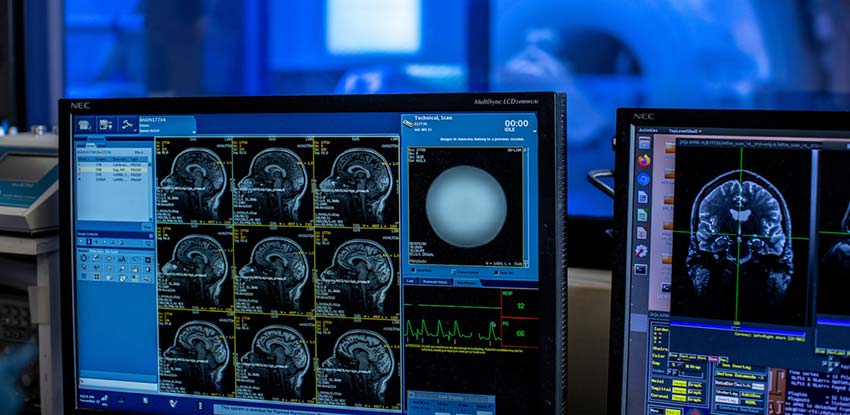What Is Brain Damage at Birth?
Brain damage at birth refers to when any type of birth complication or injury results in disruption or impairment to a newborn’s natural cognitive functions. These impairments can cause other disorders outside of the brain that come with their own physical symptoms. Brain damage at birth can cause developmental delays and injuries that will require lifelong medical treatment.
The most common brain damage during or shortly after birth is hypoxic-ischemic encephalopathy (HIE) and the most devastating consequence of brain damage at birth is cerebral palsy. Both HIE and cerebral palsy caused by brain damage at birth can leave a child and their family with lifelong disability and medical expenses.

Parents of children who suffer from brain damage are often left with more questions than answers surrounding their child’s injuries. Many of them want to know how the injury occurred and if anything could have been done to prevent it. The experienced birth injury attorneys at Miller Weisbrod Olesky can help parents receive answers to these and many other questions with no upfront charge for investigating the facts of the birth. We never charge any fee or expense unless we win a successful financial recovery.
Free Legal Consultation
Birth Injury Lawyers
1-888-987-0005Our Birth Injury Lawyers are available to meet you in your home or the hospital.
While not all brain damage at birth is preventable, medical negligence can play a factor when it results in a delayed diagnosis, misdiagnosis, delayed or improper treatment, or delivery room errors that create or worsen the injuries. In these instances, families may have a case for medical malpractice.
Common Causes of Birth Related Brain Damage
Brain damage can happen for numerous reasons. Some causes happen during pregnancy, but others can occur during the process of labor and delivery or shortly after birth during the neonatal (newborn) period. In many instances, a blockage of some sort in the body will restrict blood flow and oxygen to the brain. This plays a key factor in the most common brain-injury-related conditions like cerebral palsy and hypoxic-ischemic encephalopathy (HIE).
These are some of the most common causes behind a child’s brain damage:

- Restricted Blood Flow and Oxygen: Adequate blood and oxygen circulation to the brain is imperative to a growing child’s development in the womb. The brain needs oxygen as a fuel source to power brain cells responsible for all cognitive functions such as thinking, speaking, having memories, and control of motor skills required to move.
Oxygen deprivation can occur from different blockages like blood clots or when a blood vessel ruptures, leading to an oxygen deficiency (hypoxia) or a complete lack of oxygen altogether (anoxia). Hypoxia and anoxia is often a common factor in cases of cerebral palsy and hypoxic-ischemic encephalopathy (HIE), and it can also play a role in causing several types of strokes and seizures in neonates. - Birth Trauma to the Head: Birth trauma to the head is another common cause for brain damage in infants. Any type of injury to the head during the process of labor and delivery can severely affect the child’s cognitive function. Birth trauma to the head commonly occurs in cases of prolonged and arrested labor, or in the misuse of forceps and vacuum extractors. Sometimes birth head trauma can occur due to umbilical cord complications where the umbilical cord gets wrapped around the child’s neck.
Birth trauma to the head can result in multiple types of brain damage, including Caput succedaneum, brain bleeds, and various types of strokes and seizures. - Neurological Dysfunction: Neurons are cells that send messages from the brain to other muscles and body parts that allow for all brain and bodily activity. If someone has neurological dysfunction, it can mean that their neurons aren’t transmitting or sending these messages properly throughout the body, which can result in involuntary muscle spasms or the inability to speak or move.
Neurological dysfunction can play a role in specific injuries like cervical dystonia or hemiplegia, and they can be one of several contributing factors behind cerebral palsy disorders and hypoxic-ischemic encephalopathy (HIE). - Maternal Infections: Certain infections of the mother’s immune system can affect the brain of her unborn child. When the mother’s immune system detects infection, the body produces an influx of signaling proteins called cytokines to fight off the infection.
Cytokines can trigger inflammation when fighting off germs, and inflammation that surrounds the fetus can negatively affect brain function. This is especially true if cytokines cause inflammation directly within the baby’s developing brain. This process has been linked to brain damage in newborns and can be an early indicator for certain types of cerebral palsy like spastic diplegia (spasticity in the legs). It can also lead to brain-injury-related seizures.
What are Common Brain-Damage-Related Injuries?
It’s important to note that many of these brain-damage-related injuries are not mutually exclusive. Having one injury can often be a precursor to developing another, more serious condition. It’s important to know the signs and symptoms of your child’s birth injuries and the corresponding treatment needed for them.
Below are some of the most common birth injuries caused by brain damage:

Birth Asphyxia (Hypoxia-Anoxia)
Birth asphyxia is sometimes used to describe a condition when the oxygen supply to the brain is cut off. This condition usually causes permanent brain damage. Many babies who suffer from a deficiency in oxygen (hypoxia) or a complete lack of oxygen (anoxia) in the perinatal phase (the period occurring shortly before and after birth) can develop hypoxic-ischemic encephalopathy (HIE), which occurs when blood flow to the brain is reduced or the oxygen content in the blood is extremely low.
Cerebral palsy is a common consequence of having hypoxia or anoxia during labor and delivery or shortly after birth. The leading cause of cerebral palsy has been recognized as a hypoxic or anoxic birth injury.
Hypoxic-Ischemic Encephalopathy (HIE)
Hypoxic-ischemic encephalopathy is a type of birth complication that occurs when the baby’s brain is deprived of oxygen. HIE usually occurs during the birthing process. Babies with severe HIE may experience developmental delays, cognitive defects, or conditions, such as cerebral palsy, which can have severe lifelong consequences.
Cerebral Palsy
Cerebral palsy refers to a group of neurological disorders that may impact a child’s ability to move, use muscle coordination, and maintain posture and balance. Cerebral palsy may sometimes occur when the medical team fails to perform a timely cesarean section, or makes other medical errors that cause brain damage.
Cervical Dystonia
Cervical dystonia is a neurological disorder causing the brain to send abnormal signals to the muscles in the body. This disruption can lead to painful, involuntary contractions of the neck muscles that cause a baby's head to twist or turn to one side. The involuntary movements cause also cause the infant’s head to jerk forward or backward, making it difficult for them to maintain a stable position.
The exact cause of cervical dystonia is not fully understood. However, certain injuries at birth or medication errors, may increase a newborn's risk of developing this disorder. A child diagnosed with this condition may require extensive treatment and ongoing care for the rest of their life.

Hemiplegia (Brain or Spinal Cord Injury)
Hemiplegia refers to a condition characterized by paralysis ("plegia"), or the complete loss of motor function on one half ("hemi") of the body. This condition is often the result of damage to the areas of the brain that control muscle movements (cerebral hemisphere), frequently occurring due to traumatic brain injury during childbirth.
Hemorrhagic Stroke
A hemorrhagic stroke in a newborn occurs due to a blood vessel rupturing and bleeding either inside or on the surface of the brain. Arteries and smaller blood vessels form pathways that carry blood from the heart to the brain. If the blood vessels are abnormally developed, they can prevent the brain from getting oxygen, leading to a hemorrhagic stroke.
Caput Succedaneum and Cephalohematoma
Caput succedaneum is a neonatal birth complication involving localized swelling or edema that may be present on the newborn’s head after a vaginal delivery. The edema (swelling due to excess fluid trapped under the baby’s scalp) is usually benign resulting from the compression and pressure on the baby’s head as they pass through the birth canal.
Cephalohematoma is a birth complication involving buildup of blood from broken or damaged vessels (hemorrhage) that may occur between the baby’s skull and outer layer of skin during the birth process.
These injuries can occur when there is prolonged labor or if the baby’s head is stuck due to cephalopelvic disproportion, improper vacuum extractor delivery or other common birth complications. Sometimes caput succedaneum or cephalohematoma can lead to more serious birth complications, such as newborn jaundice.
Neonatal Intracranial Hemorrhage (Childbirth Brain Bleeds)
A neonatal intracranial hemorrhage (ICH) or brain bleed is a birth injury that may occur during childbirth, resulting in bleeding inside the baby’s brain. In this birth complication, the tearing of blood vessels within the baby’s brain causes the blood to spread to other parts of the brain tissue. Initial symptoms may be subtle, and the medical team assisting with the labor and delivery should be trained to detect, prevent, and minimize brain bleeds.
Hydrocephalus
Hydrocephalus, or "water on the brain," is a medical condition that occurs when there is an excessive buildup of Cerebrospinal Fluid (CSF) in the brain. Although this fluid is a normal and necessary part of the brain's functioning, if there is a blockage flow, a lack of absorption, or overproduction of this fluid, it can lead to increased pressure on a baby's brain, expand their skull bones, and cause brain damage of varying severity.

Neonatal Stroke
Perinatal stroke, also known as an ischemic attack or a cerebrovascular event, is a life-threatening birth complication that occurs when the blood supply to a part of the baby’s brain is cut off. Perinatal stroke can occur anytime from 20 weeks gestation to 28 days of birth, but it’s most commonly seen during the first week after birth.
Strokes can be caused by a blot clot, a brain bleed or birth trauma that can lead to either a brain bleed or clot. Strokes can also be the result of or occur along with hypoxic-ischemic encephalopathy (HIE), which results in birth asphyxia. When blood supply to the brain is cut off or restricted, this causes brain cells to die.
Periventricular Leukomalacia (PVL) Brain Injury
PVL is damage to the inner part of the baby’s brain (white matter), around the ventricles that contain cerebrospinal fluid. Premature babies are at a higher risk of PVL. Babies with this birth complication are also at an increased risk of intra-ventricular hemorrhage, sepsis, seizures, respiratory distress syndrome (RDS), and cerebral palsy.
Infant Seizures
Neonatal seizures or convulsions are said to occur when a baby suffers from epileptic fits during the neonatal period (first 4 weeks of birth). Neonatal seizures are usually a consequence of prolonged fetal distress during the labor and delivery process. Babies with this birth complication also have an increased risk of hypoxic-ischemic encephalopathy, leading to cerebral palsy.
Spastic Diplegia
Spastic Cerebral Palsy is an irreversible injury involving damage to the motor cortex before or during the delivery of a baby. Spastic diplegia refers specifically to severe muscle stiffness in the legs. A 2019 study found that approximately 35% of children with cerebral palsy have spastic diplegia.

Frequently Asked Questions
How Can I Tell if My Baby Has Brain Damage?
It can be difficult to distinguish between normal behaviors in neonates and behaviors of brain damage. While these following signs and symptoms may be indicative of brain damage, it’s important to note that it isn’t always the case. If your baby is showing multiple of these signs, talking with your primary healthcare team should be the first step.

Common indicators include:
- Abnormal cranium shape (enlarged forehead, small head/skull)
- Abnormal/distorted facial features
- Abnormal eye movement
- Stiffness in neck
- Malformed spine
- Loose or stiff muscles
- Seizures
- Tremors
- Excessive and/or high-pitched crying
- Excessive drooling
- Difficulty eating or swallowing
This list is not all-encompassing. For more information on any concerns, talk with your primary healthcare provider.
Can a Baby Recover From Severe Brain Damage?
This depends on the agreed-upon definition for “recovery.” If a child truly has severe brain damage, it is unlikely they will ever recover to a status that won’t require lifelong medical supervision and treatment.
However, not all brain damage is considered permanent. Different treatment options exist that can assist brain-damaged children in regaining control over certain motor skills over time. This will depend on the specific conditions unique to each child and their conditions.
Can Too Much Oxygen as a Baby Cause Brain Damage?
Yes. Certain heart conditions can create circumstances where higher levels of oxygen flow through the bloodstream. Too much oxygen in the blood can potentially impact the child’s brain function. Additionally, breathing too much oxygen can cause damage to other parts of the body such as the lungs or the eyes.
How Long Can a Baby Go Without Oxygen Before Brain Damage?
Listed below is a table for the different consequences toward the child’s brain as time without oxygen increases:

Not all brains will react the same way to oxygen deprivation, and these windows of time can fluctuate depending on the situation. Certain factors that can affect this are the degree of oxygen deprivation and how developed the brain is at the time oxygen was cut off.
Did Medical Negligence Cause My Child’s Brain Damage?

Brain damage can sometimes be preventable with proper medical care. Medical negligence, such as a misdiagnosis or failure to catch early symptoms of a problem, or even operating errors during delivery can cause a birth injury that results in brain damage.
If a family believes medical negligence contributed to a birth complication or birth injury, legal support may be an option. A knowledgeable birth injury attorney can review the medical records and circumstances to assess whether a claim exists.
Parents whose children suffer from brain damage as well as parents who have suffered the loss of their baby deserve to know whether it could have been prevented. Our dedicated birth injury lawyers want to help you find those answers and obtain the funds necessary to improve the quality of life for your child.
If your child has been diagnosed with brain damage and you suspect this may have been caused in part by medical mistakes, Miller Weisbrod Olesky will thoroughly investigate the facts and hold the responsible medical providers accountable by pursuing medical malpractice claims against them.
Sometimes families are hesitant to reach out to a medical malpractice attorney or law firm. They may feel overwhelmed by their circumstances or are worried that a law firm will not be able to help them. But the only way to find out if you have a case is to talk to an attorney who understands how birth injuries can lead to developmental delays and other complications that require long-lasting medical support.
Statute of Limitations in a Birth Injury Lawsuit

A statute of limitations (SOL) is a law that sets a time limit on how long an injured person has to file a lawsuit after an accident. It is essential to understand that statutes of limitations vary based on the type of case and the state where it is filed. For instance, the deadline for birth injury claims is typically different from other claims, such as injury to personal property, fraud, contract disputes, and collection of debts.
Generally, the clock starts ticking on the date the injury occurred. However, there are exceptions to this rule, and in some cases, the statute of limitations starts when a person discovers or reasonably should have discovered an injury. When dealing with government agencies, SOLs can become even more complex.
For example, if the party that injured you was:
- A federal employee
- Employed by a military hospital, Veterans Administration facility, or a federally funded medical entity
You may need to file a birth injury claim under the Federal Tort Claims Act (FTCA). In FTCA cases, claimants must go through certain administrative procedures before filing a lawsuit. In some states, if the negligent party was a local or state government hospital or the doctors and medical providers are employees of a governmental entity, the time period in which you must give "notice" may be shorter.
If your case is filed outside of the statute of limitations, it will typically be dismissed, and you will not be eligible to recover compensation for your injuries. Determining when a statute of limitations begins on your case can be tricky. If you're considering pursuing compensation contact a birth injury attorney as soon as possible is in your best interest.
The Birth Injury Attorneys at Miller Weisbrod Olesky Can Help

Birth complications that lead to brain damage are preventable in many cases, but it takes a detailed expert review of the facts and circumstances of your pregnancy and your child's birth to determine whether the injury was the result of medical malpractice.
Our Process
At Miller Weisbrod Olesky, a team of committed birth injury attorneys, nurses and paraprofessionals uses our detailed medical negligence case review process to assess your potential birth injury case. We start by learning more about you and your child and the status of meeting/missing developmental milestones. Then we gather medical records to determine what happened before, during, and after your delivery. We call in skilled medical experts who review your records and let us know if they think medical errors could have caused you or your child's injuries.
If we feel medical negligence caused or contributed to complications with your pregnancy or your child's injuries, we meet with you to discuss how you can receive compensation from the medical professionals who made the errors.
At no point in our legal intake process will we ask you to pay anything. The medical review of your case and the consultation are free. We only receive payment when you do. The sooner you reach out to us, the sooner we can begin investigating your case and gathering the evidence needed to support your claim.
We work on a contingency fee basis, meaning you won't pay any legal fees unless we win your case. Contact us today to schedule your free consultation by calling our toll-free line at 888-987-0005 or by filling out our online request form.
